Content
Are you looking for detailed guidance on how to start medical device software development? Whether you are a small business working with healthcare organizations, or an established tech company expanding its services into the medical space, this blog post will help you discover everything related to creating and deploying medical device software.
We will cover all the steps involved in developing medical device software, along with any applicable regulatory requirements and estimated costs. With clear information about what it takes to create great medical technology software solutions, your company will be better prepared for success as you take on these new challenges. Let’s get started!
What is Medical Device Software Development?
Medical device software development is the process of designing and creating medical devices, utilizing software-based solutions to ensure optimal usage and performance. By combining medical knowledge with computer science, medical device software developers create products that can improve the diagnosis and treatment of medical conditions as well as provide a better understanding of medical procedures.
Developing medical device software requires sound coding skills and knowledge in both medical science and information systems; additionally, an understanding of user experience (UX) design principles helps to ensure that the product interactivity is best suited for the intended user.
Read Also: Start to Develop a Hospital Management System: Steps, Price, Features
Trends in medical device software development
Medical device software development is an increasingly important field. The use of software for medical devices has grown significantly, thanks to technological advances and the increased demand for improved patient care. To keep up with the latest popular trends in medical device software development, it is important to understand the various technologies used, as well as emerging trends in the industry.
One of the major trends in medical device software development is utilizing AI-based solutions. This means that developers are creating systems that can analyze large amounts of various data and provide insights into how a certain treatment should be administered or how a certain condition should be monitored. AI-based systems can also help reduce costs and improve efficiency by automating manual processes.
In a survey conducted by Deloitte, 73% of healthcare organizations reported that they had implemented AI technologies, with medical device software development being one of the key areas of application. According to MarketsAndMarkets research, the global AI in the healthcare market is projected to reach a value of $45.2 billion by 2026, with a compound annual growth rate (CAGR) of 44.9% from 2021 to 2026.
Read Also: A Guide to Medical Imaging Software Development
Another trend that has been gaining traction is leveraging cloud computing technologies. Cloud computing allows developers to store large datasets securely and access them from anywhere with an internet connection. This makes it easier for healthcare providers to share information across locations and collaborate on treatments more effectively. Additionally, cloud computing can be used to power data analytics tools which allow doctors and other healthcare professionals to gain deeper insights into patients’ lives and illnesses.
The use of mobile technologies is also growing rapidly in medical device software development. Many healthcare providers are now using mobile apps to deliver personalized care directly to their patients’ fingertips, such as providing medication reminders or tracking vital signs remotely. Mobile apps also enable doctors and nurses to access patient records quickly, improving communication between healthcare professionals and patients alike.
Types of medical device software development
As more and more medical device manufacturers rely on cutting-edge technology to design, develop, and market their products, the need for software development is increasing. It’s important for medical device manufacturers to understand the types of software development that can be used in their processes. Let’s take a look at some of the most common types of medical device software development:
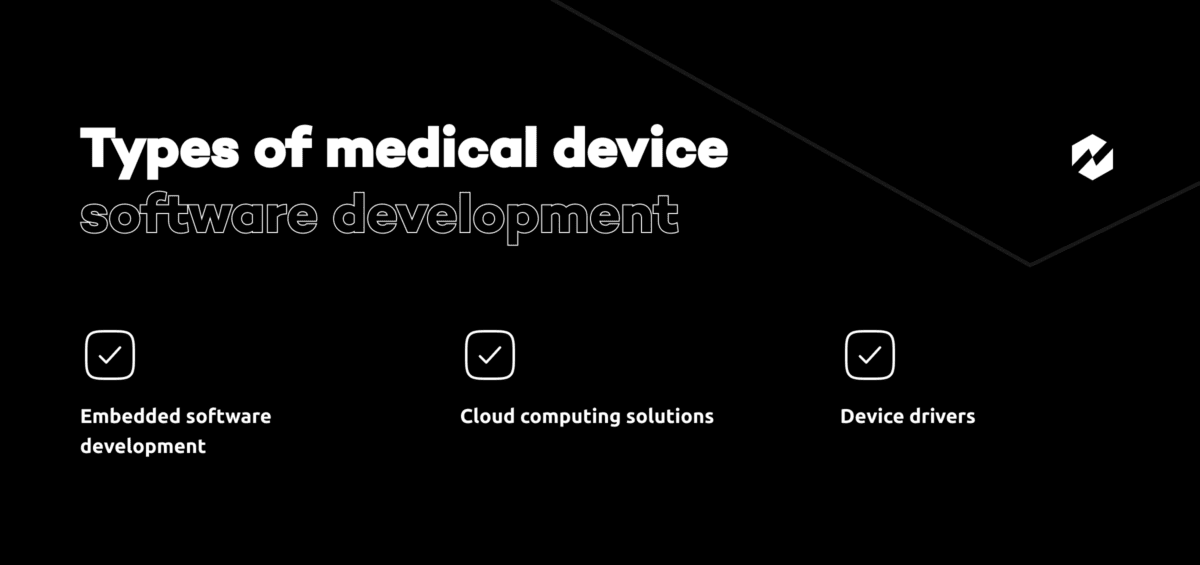

- Embedded software development. It is a type of software development that involves creating code that will control hardware such as microcontrollers or DSPs (Digital Signal Processors). Embedded software development often requires specialized knowledge and experience in order to create reliable and effective code. This type of software development is often used for medical devices such as pacemakers, defibrillators, insulin pumps, and other medical devices that require complex hardware control.
- Device drivers are pieces of code that allow a computer system to interact with hardware components. For example, a printer driver allows your computer to communicate with a printer so that you can print documents from your computer. Medical device manufacturers often use device drivers in order to allow their devices to be connected to other systems or networks. Device drivers enable data transfer between systems as well as communication with external devices such as monitors, keyboards, or other peripherals.
- Cloud computing solutions are becoming increasingly popular in the healthcare industry due to their scalability and cost-effectiveness. Cloud computing solutions allow medical device manufacturers to store data securely in the cloud while also giving them access to powerful analytics tools which can help them gain valuable insights into patient information or trends within the industry. Cloud computing solutions also provide secure access for remote users, which makes it easier for medical device companies to collaborate with others outside their organization.
9 Main Stages of Successful Medical Device Software Development
To make it easier for you to start medical device software development, our team has prepared a step-by-step guide for you. Let’s take a closer look at each stage of medical device software development:


Step 1: Come up with your medical device software idea
Developing medical device software is a complex and multi-stage process, requiring a detailed understanding of medical device requirements and regulations. Before you even begin the medical device software development process, it’s important to come up with a clear idea of your medical device concept; this requires thorough research into medical device software requirements and coding standards.
Factors such as risk analysis, medical usability tests, and medical regulatory considerations should all be taken into account before you begin successful medical device software development.
Read Also: Telemedicine Software Development: Standards, Features, and Cost
Step 2: Conduct in-depth product discovery
Developing medical device software requires a comprehensive understanding of medical device software requirements. To meet these requirements, it is important to conduct in-depth product discovery to uncover the product’s current problem and decide how medical device software helps provide a suitable solution.
This process begins with independently evaluating customer needs and medical industry regulations, consolidating insights and data, then moving onto identifying medical device digital objectives and users, which is essential for creating medical device software that meets regulatory approval.
Product discovery provides the basis for defining key medical device functions and features beyond the primary digital use case, supported by medical research and clinical evaluations. Ultimately, this step sets up subsequent stages for successful medical device software development.
Step 3: Make a list of basic software features
Before medical device software can be developed, the basic features of the software should be determined. Making a list of these features before beginning development helps to ensure that even the most minute details are accounted for.
This step in medical device software development will ultimately determine how successful the product is, as it lays out a blueprint from which the rest of the project will follow. Many developers create an initial feature map that they can add to while working through development to ensure that all necessary features are addressed.
By carefully mapping out every detail during this step of medical device software development, projects are much more likely to move forward without unnecessary delays or remakes due to missing elements.
Read Also: How to Create a Mental Health App in 2023? [Features, Roadmap, Real Cases]
Step 4: Build medical device software architecture
This stage is essential in determining the remainder of the development. It’s helpful to identify a best practices approach while implementing an extensive and robust medical device system that handles safety measures, compliance concerns, and user experience objectives.
During this step, architects should design medical device software with an eye towards modular programming, scalability, and flexibility for future growth; it’s crucial in meeting medical device standards and achieving success in medical device software development.
Usually, solution architects use the following technologies in the medical field:
- Healthcare-specific knowledge (HL7 – FHIR, Hospital Information System (HIS)
- Health Information Exchange (HIE)
- EMR Systems experience
- EHR Systems experience (EPIC, Cerner, Allscripts, etc)
- Hospital Data Integration (Patient Portal, HIPAA / GDPR)
- InterSystems IRIS
- Datalake
- Datafabric
- Healthconnect
Step 5: Create UI/UX design
Knowing how to design software for medical devices can be the difference between success and failure. As such, medical device software development is an important step in medical device production. UI/UX design is a key part of this process and involves the proper integration of user experience with medical functionality that adheres to medical requirements.
User interface designs incorporate visual elements and interactive media management tools, which help medical teams understand and navigate different medical situations. Crucially, these designs must meet all medical safety regulations before being rolled out in healthcare organizations.
With a successful UI/UX design, medical device suppliers can ensure their software meets the needs of both clinicians and patients alike. Some examples of medical software design include electronic health record (EHR) systems, clinical decision support tools, and telemedicine platforms. Each of these solutions is created with the user’s unique needs in mind, ensuring that they are efficient, user-friendly, and effective in enhancing patient outcomes. Medical software design is essential in modern-day healthcare and continues to drive innovation within the industry.
Step 6: Conduct product usability testing
The medical device software development process is highly regulated and lengthy; however, following the steps closely and carefully can lead to successful medical device software. One such step is to conduct product usability testing.
This involves recruiting volunteers that fit the target user base to test the medical device on ease of use and then collecting feedback for improvement. This process sharpens the medical device software design by ensuring that it matches its intended use within a real-world context.
Product usability testing must meet standards outlined by medical regulatory bodies before medical devices hit the market. Thereby, successful medical device software development must include this important stage.
At RewiSoft, we use our in-house UX lab for usability testing. We use UX Eye Tracker, which allows for exploring user behavior during interaction with the product. Only 1% of companies use this method. An eye tracker is a unique tool that captures the movement of a person’s gaze and helps get a record of where and for how long the user was looking.
Step 7: Move on to medical device software development
After the design is ready, developers should use the documentation and architecture from previous steps to write code for all the product components. The development part is divided into 2 steps: front-end development and back-end development. At RewiSoft, we usually assign 2+ developers to run this stage. Let’s take a closer look at the main steps of the travel app development stage:
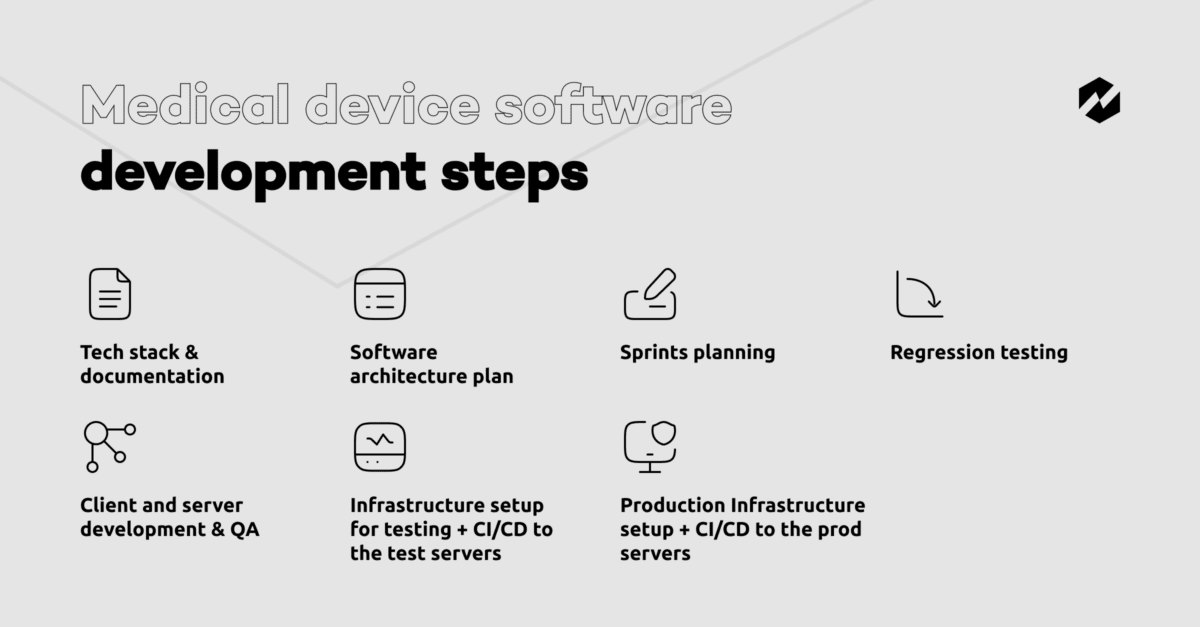

- Tech stack & documentation. Medical device software engineers carefully examine your project to ensure the most beneficial technologies are chosen. Comprehensive technical documentation outlines each detail of feature and functionality, as well as user roles interactions – providing you with a winning end result!
- Software architecture plan. Developers create the backbone of a software product through an artful combination of monolith and microservices, curating controllers to maximize performance and crafting APIs from the ground up. With that in place, they then go on to design user-friendly interfaces which elegantly demonstrate how all components come together.
- Sprints planning. Product development is essential for success, and the creation of features allows teams to create a structured sequence that prioritizes efficiency. Establishing this foundation empowers project completions that go beyond expectations.
- Infrastructure setup for testing + CI/CD to the test servers. The team harnessed the power of DevOps, creating a production-level cloud environment that enabled customers to test their software extensively. This system is additionally primed for automated changes in this simulated setting – promoting both efficiency and efficacy throughout development!
- Client and server development & QA. At this stage, client and server parts of the product are developed (development of UI components, API, etc.) and tested.
- Regression testing. QA tests the entire product thoroughly. The team fixed bugs that may have appeared when they were adding new features and product components.
- Production Infrastructure setup + CI/CD to the prod servers. Medical device software developers provide a fully operational cloud environment, offering robust scalability and adaptability to shifting demands. Advanced domain and system configurations guarantee that any modifications made will be quickly implemented on the platform.
Step 8: Integration of HiPAA/GDPR systems
In today’s world, data privacy is more important than ever before. This is especially true when it comes to medical devices. That’s why one of the most important steps in successful medical device software development is the integration of HIPAA/GDPR systems. These systems help ensure that patient data is kept safe and secure at all times.
As medical technology continues to advance, it’s essential that developers make data privacy a top priority. By taking the necessary steps to integrate these systems into their software, they’re not only protecting patient data but also building trust with their users. Ultimately, this is key to creating successful and sustainable medical device products.
Read Also: How to Develop Healthcare Software Product?[ Vendors, Standards, and Real Cases]
Step 9: Test your medical device software
Once medical device software is developed, it must be rigorously tested for accuracy and efficacy before being approved for use. The testing process will focus on verifying the medical device’s conformance to federal medical device regulatory requirements and standards, as well as user requirement specifications from the medical device engineering process.
The medical device software testing phase is built upon integrated simulations, performed within virtual test environments, leading up to field trials of the medical device hardware and software in an actual setting. With a successful pass of all tests, medical device developers can confidently move forward that their medical device – and the valuable healthcare it provides – meets safety and quality standards.
Step 10: Maintain, launch and support your software
When developing medical device software, the final stage is no less important than the previous ones. After completion and testing of the creation according to medical standards and FDA regulations, the medical device software must be maintained, launched and supported. This involves ensuring that bugs and other issues are fixed, properly deploying the system and training users if necessary, all while providing ongoing technical assistance and maintenance.
A successful medical device software development process will rely on taking all nine stages of this process into account in order to create a reliable medical device.
RewiSoft Experience in Medical Device Software Development
RewiSoft team provides one of the best medical device software development services. Our healthcare development team’s insight and expertise ensure a secure, simple-to-use, compatible product that helps medical institutions provide top-notch care. From hospitals to pharmaceutical companies, we help them implement cutting-edge solutions for their core processes – improving the doctor/patient experience while driving efficiency across various workflows.
We recently worked on the CareSYNC project. CareSYNC is a hospital management system for efficient clinic operation. The main goal of this platform is to simplify the workflow for doctors, handle the queue in the waiting room, speed up healthcare delivery and enhance the overall patient experience.
Our main challenge was to rebuild and redesign existing software that would meet the client’s expectations and the required clinic standards. On the way to achieving our main goals, we faced such challenges:
- Transition of employees and patients from old methods to a new platform. Our global aim was to deliver a brand-new online tool that will seamlessly transit clinic employees and patients to a new-level platform with high-level automation and workflow optimization.
- Provide the fastest possible data exchange for constant and accurate synchronization. The level of data exchange affects the speed of providing medical services to patients. Therefore, when working on the product, we had to pay special attention to ensuring fast and stable data exchange without the risk of failures.
- Improve UX to deliver an exceptional patient experience. One of the core requirements for medical software is the interface simplicity and ease of system navigation. Our next task was to convey a logical sign system recognizable by any user and provide great UX. The RewiSoft team has gone through numerous testing cycles to agree on a sign system design accessible to everyone.
When developing a hospital management system for our client, our team identified the previous version’s weak spots and improved the product’s visual and functional parts. We developed a custom solution according to our client’s expectations and clinic standards.
As a result, our client released fully-fledged and unique software that can continue to scale and win the market competition. I
Have an idea for your next project and need help bringing it to life?
The Main Specifics of Medical Device Software Development Life Cycle
The development of medical device software is a complex process that requires careful analysis, planning, and execution. Every step in the medical device software development life cycle (SDLC) is critical to the success of the project. Let’s take a look at the specifics of this important process:
Planning and analysis
The planning and analysis phase is the first step in the SDLC. During this stage, all relevant stakeholders must meet to discuss the project objectives, budget, timeline, and other essential details. It’s also during this phase that a detailed analysis of any existing technology should be conducted to determine what needs to be updated or replaced. This phase should also include an analysis of any potential risks associated with developing a medical device software product.
Design and implementation
Once all stakeholders have agreed upon a clear plan for development, it’s time to move on to design and implementation. This phase involves creating detailed technical specifications for how each component of the system will function, as well as designing user interfaces for each part of the system that can be easily understood by users. Once these steps are complete, implementation begins with coding and testing. It’s during this step that developers must ensure that all components interact properly with one another and work as expected when put into use by end-users.
Maintenance and support
Once a product has been developed, tested, and released, it’s important to maintain it over time if you want it to remain effective long-term. Regular maintenance can help identify issues early on before they become too serious or costly in terms of time or money. Additionally, providing technical support for users can help them get up-to-speed quickly with any new features or fixes introduced since their last update.
The medical device software development life cycle is an important part of ensuring that products are safe and effective when they reach end-users. By understanding each stage of this process – from planning through maintenance – medical device developers can ensure their products provide users with the best possible experience while adhering to industry regulations and standards for safety and efficacy.
With proper planning and execution throughout every stage of development, your team can create quality medical device software products quickly and efficiently while minimizing risk along the way!
Read Also: A Step-by-Step Guide to Healthcare Web Application Development
The List of The Main Medical Device Software Requirements and Standards
Medical device software has become an integral part of the healthcare industry. Its use is increasing as doctors and other healthcare professionals rely more on digital technologies to diagnose, treat, and monitor their patients. But before any medical device software can be used in a clinical setting, it must adhere to certain requirements and standards set by governing bodies. Let’s take a look at some of the main requirements and standards that must be met in order for medical device software to be approved for use:
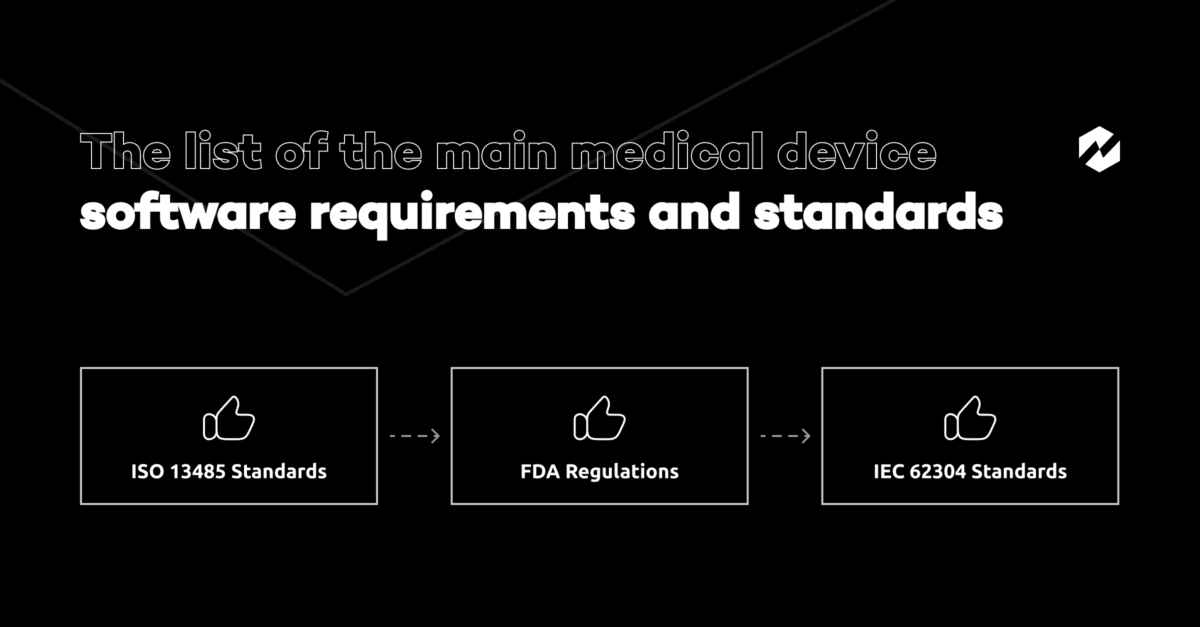

ISO 13485 Standards
The International Organization for Standardization (ISO) is one of the most widely recognized organizations in the world when it comes to setting standards for various industries. When it comes to medical device software, ISO 13485 sets out the requirements for quality management systems (QMS).
These include key elements such as design control, document control, production validation and verification procedures, corrective action processes, internal auditing processes, traceability systems, risk management processes and more. All these elements must be in place before medical device software can be released for use in a clinical setting.
FDA Regulations
The US Food & Drug Administration (FDA) is responsible for overseeing the safety and efficacy of all medical devices that are used in America. The FDA has numerous regulations pertaining to all aspects of medical device software development, including design controls, usability testing protocols and post-market surveillance processes. All these regulations must be followed if a medical device vendor wants their product to be approved by the FDA for sale in the USA.
IEC 62304 Standards
The International Electrotechnical Commission (IEC) is another globally recognized standard-setting organization with regard to electronic products. IEC 62304 sets out specific requirements related to how medical device software should be designed, implemented and maintained throughout its lifecycle from concept through production release.
This includes key elements such as system architecture design; risk analysis; security; change management; configuration management; defect tracking; quality assurance; documentation; training; maintenance strategies; validation plans etc. All these elements must be taken into account when developing any new medical device software product or making changes to an existing one.
Keeping up with all these standards and regulations can seem daunting, but it is essential if you want your medical device software product to be approved for use within a clinical setting or sold commercially in any market around the world. Adherence to these essential requirements will ensure that your product meets all necessary safety guidelines while still providing valuable functionality that meets user needs effectively.
Following proper protocols also helps protect your business interests by ensuring compliance with applicable laws, which helps maintain good public relations with customers and stakeholders alike. In short, meeting these requirements means better patient care while keeping your business safe in an ever-changing digital healthcare landscape!
Read Also: How to Create an Online Pharmacy Website? [Pharmacy App Development]
How to Hire Medical Device Software Developers
The hiring process involves finding the right individuals with the appropriate technical skills and medical device expertise. In order to do this, it is important to vet potential candidates through a rigorous recruitment process thoroughly.
Moreover, medical device software developers should be knowledgeable of medical trends both in medical device software and the medical industry as a whole so that they can provide a comprehensive understanding of medical industry software needs.
Read Also: How Much Does It Cost To Outsource Website Development?
Furthermore, it is important for developers to demonstrate creativity and adaptability to changing medical design requirements and deliver robust designs on time and within budget. And in some cases, developers should be certified specialists with permission to use certain technologies. When you find the ideal medical device software developer, the possibilities are truly endless!
We have compiled a small guide that will help you hire excellent medical device software developers. Let’s look at each step in more detail:
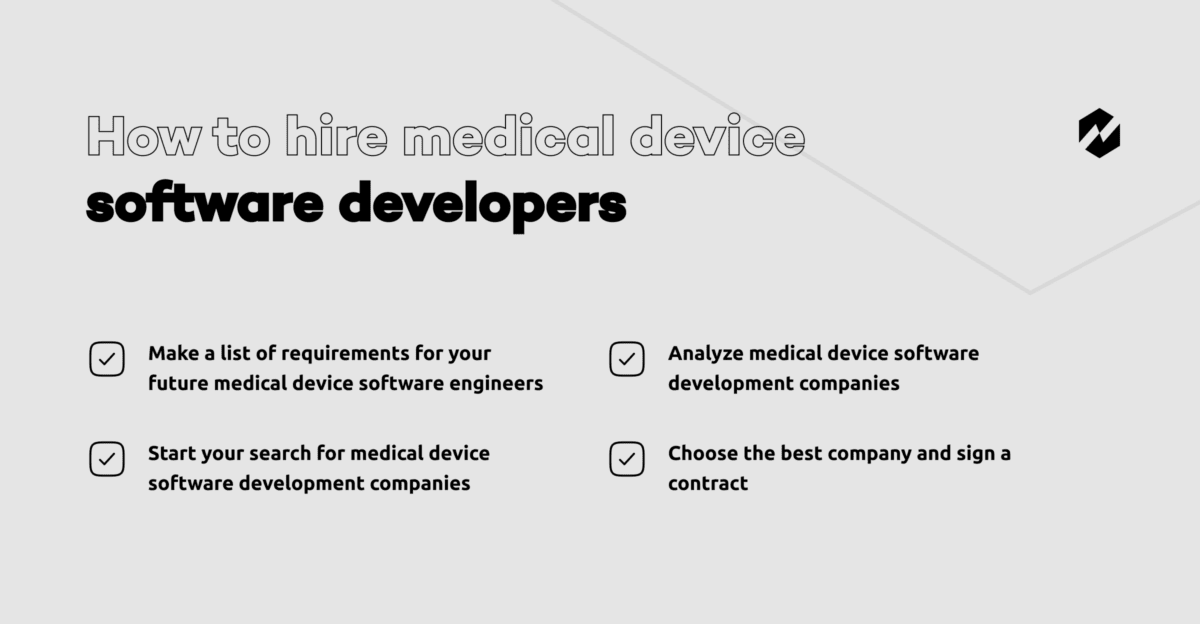

Make a list of requirements for your future medical device software engineers
When you are looking to hire medical device software developers, it’s important first to create a comprehensive list of qualifications you require. These criteria should encompass the medical device software development skills as well as the soft skills necessary for the position.
It’s important that medical device software developers have a strong understanding of medical protocols, medical science, and medical technology. Additionally, they should be able to collaborate with other developers effectively and possess excellent problem-solving abilities.
Once your list is complete, you will be sure to hire medical device software developers who can help push your medical technology forward.
Start your search for medical device software development companies
When looking to hire medical device software developers, one of the best places to start is by researching medical device software development companies. Companies specializing in medical device software development will have a different level of experience and expertise than more general software development companies.
It can be beneficial to work with an experienced medical device software developer as this type of engineering requires a unique set of skills that not all traditional software developers may possess. Start compiling a list of the medical device software development companies that best meet your project needs and then move on to the next step of evaluating them further.
Analyze medical device software development companies
With medical device software development becoming increasingly complex, it is important to determine whether you are partnering with a medical device software developer who is up to date with the latest technology and trends. This involves reviewing medical device software development companies and analyzing their processes, experience, and proven track record of success.
When considering medical device software development rates, flexibility and scalability also play major roles in finding a good fit for your project objectives. Investing time into researching medical device software developers can pay off big in the long run by ensuring that your company’s medical software is reliable, secure, and able to keep up with changing requirements.
Choose the best company and sign a contract
Once you have found the best medical device software development company for your project, it is essential that you sign a contract with them. This will ensure that all expectations are made clear prior to the commencement of work, setting you up for success from the beginning.
Learn more about how to hire the best team for your project in our past articles:
- How to Hire Software Developers for a Startup: a Step-by-Step 2023 Guide
- How to Hire a Dedicated Software Development Team?
RewiSoft Tips For Software Design For Medical Devices
As the medical device industry continues to evolve, software designers must stay ahead of the curve. Designing software for medical devices can be a tricky process, as it requires an understanding of user needs and safety regulations. To help make the process easier, here are some tips from our team on how to design effective and efficient software for medical devices:


Safety regulations
LSI, or large-scale integration, plays a crucial role in the design of medical devices. With the advancement of technology, medical devices now rely heavily on software, making it important for designers to consider the safety aspects of the software they create.
In order to ensure that medical devices are safe for use, manufacturers must comply with FDA regulations and standards. This means that designers need to be knowledgeable about the regulations and standards in order to design software that meets all necessary safety requirements properly.
By incorporating LSI into the design process, medical device manufacturers can create a safer and more reliable product for the benefit of patients and healthcare practitioners.
Usability considerations
User experience is a crucial component of any successful software design project, especially when creating medical device software.
This includes making sure the interface is intuitive and easy to use so users can quickly understand how to use the product without needing too much instruction or training. Additionally, it’s important to consider accessibility needs such as screen readers or text-to-speech capabilities so that everyone can access the product’s features.
Testing protocols
In addition to adhering to safety regulations and considering usability issues, another important step in designing effective medical device software is testing protocols. Software designers must test their designs extensively in order to ensure that they are free of errors and bugs before they are released on the market. Additionally, testing protocols should include real-world scenarios in order to accurately replicate how users will interact with the product in actual use cases.
How Much Does Medical Device Software Development Cost
Understanding the medical device software development cost is complex. A medical device software development project’s budget is largely determined by the complexity of the medical device itself, as well as the medical device software engineer’s experience and estimated timeline.
Different medical devices must follow different medical regulations and standards regarding safety, quality, and accuracy in order to receive approval from the FDA. Moreover, medical device software engineers with more specialized knowledge may require additional payment for their services due to a higher degree of expertise in specific applications or technologies related to the medical device.
As such, medical device software development costs can vary significantly depending on an array of factors. We have prepared a table in which you will find information about the rates for individual medical device software development processes in different regions:
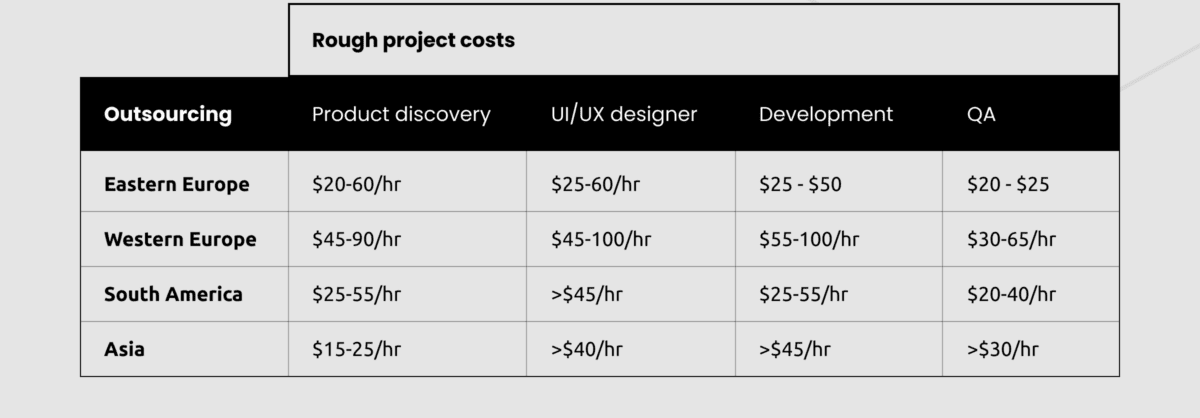

How Long Does Medical Device Software Development Take
This process often takes several meticulous steps, overseen by experienced medical device software engineers, to ensure that medical software adheres to the industry standard for quality and safety.
Generally speaking, medical device software development can take anywhere from 6-12 months, depending on the complexity of the project. There are multiple phases in medical device software development involving designing or engineering, testing and validating the medical software before it is officially launched into production.
Throughout each phase, medical device software engineers must meet regulatory guidelines for medical standards and take each step with great care. As such, medical device software engineering is a complex yet reserved field with substantial efforts poured into each project.
In the following table, you will see approximately how much time is needed for each medical device software development process for businesses of different sizes:
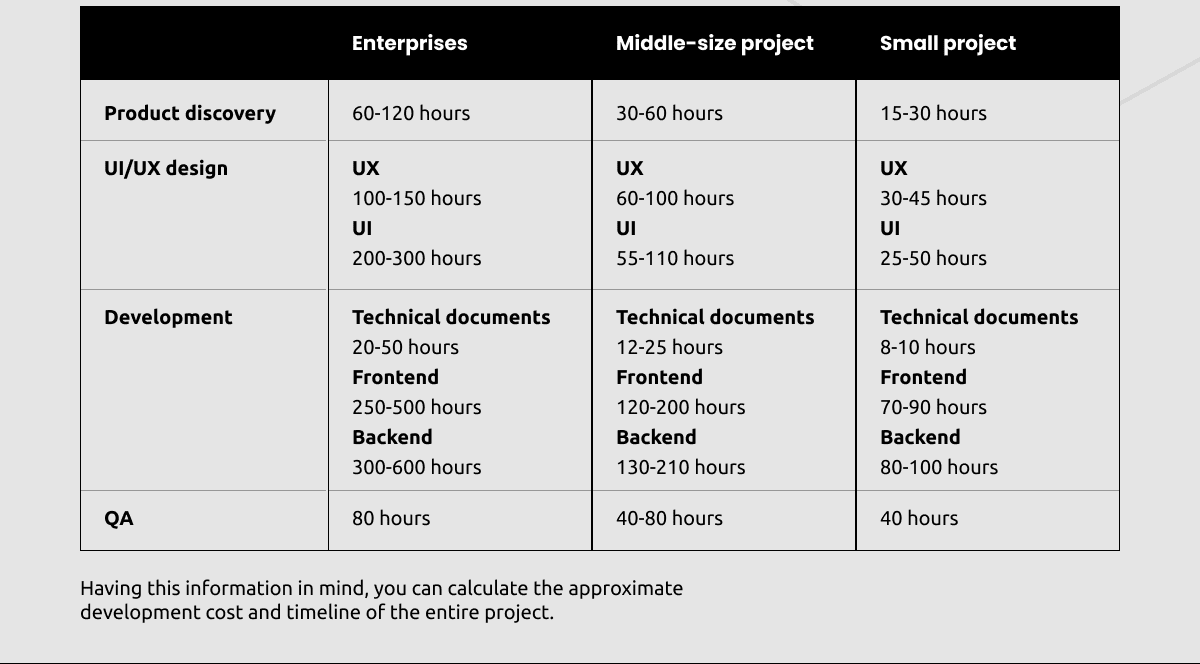

Conclusion
Software development for medical device systems is a complex but worthwhile endeavor with many potential benefits. With the help of regulatory guidance, access to specialized knowledge, and prepackaged software solutions, developers can ensure their end product meets all necessary legal compliance standards.
However, it is always best to partner with an experienced team who knows the regulations and supporting technology like RewiSoft does. RewiSoft’s experts have extensive experience in software development for this sector, so we can identify challenges that may come up during production and provide bespoke solutions tailored to fit any situation.
We also help guide customers through the lengthy clearance process so that your projects are completed as quickly as possible.
contact RewiSoft today to discuss your project and start taking advantage of our quality services.







